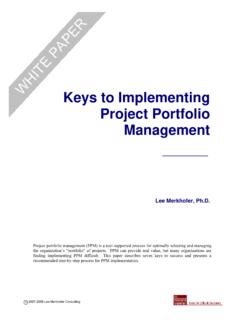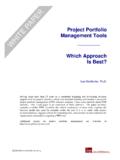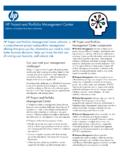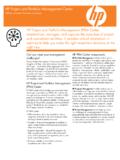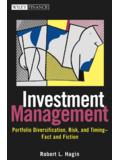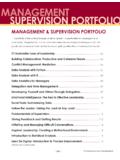Transcription of Part 1: Project Portfolio Management Tools - …
1 Project Portfolio Management Tools : Which Approach is Best? part 1: tool Options 1 2003-2014 Lee Merkhofer Consulting part 1: Project Portfolio Management Tools To survive and prosper in today's competitive, cost-conscious, and risky business environment, organizations must derive greater value from the projects that they conduct. Success requires doing the right projects, not just doing projects right. As organizations have begun to recognize the need to improve Project -selection decisions and to better manage their Project "portfolios," consulting companies and software vendors have rushed to offer Tools for the job. Most of the relevant products are marketed as Tools for Project Portfolio Management (PPM), but they may be alternatively described as Tools for Project prioritization, capital efficiency, enterprise Project Management , Portfolio analysis, multi- Project Management , asset Management , or resource allocation. The Tools being pushed in the marketplace use very different approaches for evaluating projects and recommending Project portfolios.
2 Which approach is best? This paper identifies and evaluates the PPM Tools that are currently available. As you will see, caveat emptor let the buyer beware. Although many Tools are described in marketing materials as being rigorous and quantitative, few incorporate well-established Project selection or Portfolio optimization methods. Project Portfolio Management I define PPM as a tool -supported process for selecting projects and managing the Project Portfolio for the purpose of creating the greatest possible value. Under PPM, new projects are formally evaluated, prioritized and selected; existing projects may be accelerated, killed or de-prioritized; and resources are allocated and reallocated based on maximizing productivity. PPM does not involve making Project -by- Project choices based on fixed acceptance criteria. Instead, decisions to add or subtract projects from the Portfolio are based on the impact on the total value created for the organization.
3 The idea behind PPM is to apply investment optimization methods similar to those that have proven successful in the world of financial investing to Project decisions. Developers of PPM Tools see their solutions as borrowing from the financial investment world. However, other than using the word Portfolio , few can point to any specific Portfolio optimization methods implemented in their Tools . [2] Project Portfolio Management Tools : Which Approach is Best? part 1: tool Options 2 2003-2014 Lee Merkhofer Consulting Modern Portfolio Theory The revolution in financial investing known as modern Portfolio theory was initiated in the 1950 s by Nobel Prize winner Harry Markowitz. Markowitz showed that investors could obtain significantly greater return at lower risk if, instead of choosing stocks and other financial assets based on their individual potentials, choices were made based on calculating the impact on the risk and return generated by the Portfolio as a whole.
4 Certain combinations of investments (portfolios) are efficient (they lie on an efficient frontier ) in that they create the greatest possible value for the least risk. Inefficient portfolios should be avoided. Which of the various efficient portfolios is best depends on the investor s willingness to accept risk. What enabled Markowitz to achieve his breakthrough was a clear understanding of the investor s goal; namely, to obtain a Portfolio of investments that provides the greatest possible (risk-adjusted) value. This perspective led Markowitz to a different and much better strategy for selecting investments. Although Markowitz may not have anticipated it at the time, the same reasoning applies to organizations investing in projects. The organization s goal is to choose a Project Portfolio that provides the greatest possible (risk-adjusted) value for the organization. Likewise, this revised perspective produces a much improved Project -selection strategy.
5 Challenges for Optimizing the Project Portfolio Despite the analogy between financial and Project investing, there are some key differences. Organizations conduct projects because they believe those projects will produce consequences that are good for the business. Thus, the value of a Project Portfolio is determined by the worth, to the organization, of the consequences of conducting those projects. The business consequences of projects may include improved cash flows ( , cost savings, increases in revenue), but there are other common Project benefits that cannot so readily be expressed in dollars. For example, projects may be conducted for the purpose of improving worker safety, customer service, or organizational capability. Another key difference relates to uncertainty. The returns from financial investments and projects are both uncertain. However, unlike financial assets, data on past performance is typically not available to help characterize the uncertainties over the returns from candidate projects.
6 Difficulties for measuring Project value and quantifying uncertainty posed challenges for applying Portfolio theory to projects. The Remaining Breakthroughs Since Markowitz s time, the additional breakthroughs necessary for optimizing Project portfolios have been achieved. These advances include business consequence modeling (for estimating or simulating the impact of Project decisions on business performance), probability encoding, Monte Carlo analysis, and decision trees (for quantifying uncertainty over the outcomes of alternative Project decisions), and multi-attribute utility analysis, real options analysis, and risk tolerance (for quantifying the dollar value of projects and adjusting Project value based on organizational willingness to accept risk). Project Portfolio Management Tools : Which Approach is Best? part 1: tool Options 3 2003-2014 Lee Merkhofer Consulting The relevant methodologies still had to wait for improvements in computer technology and software engineering to become fully operational.
7 Government laboratories, the military, research institutes, and others with early access to computing power and understanding of the mathematics involved have been selectively applying the techniques for years. However, only recently have suppliers attempted to create commercial products for PPM. PPM Tools Tools for PPM are evolving rapidly, and it is impossible to maintain a complete and up-to-date list of suppliers and capabilities. However, the table below provides a recent snapshot (Summer 2011) of advertised products. (There are some additional Tools claiming PPM capabilities, but unless they advertise some functionality for Project prioritization or Portfolio optimization, I do not include them in my list.) The number of tool options is truly staggering. As indicated, there are now more than 100 Tools aimed at PPM. The information in the table is intended only to provide starting points for further inquiry. In the Focus column, I ve attempted to indicate main target industries and application areas, features that the supplier emphasizes, structural characteristics ( , modular), and delivery modes.
8 At best, the information is useful for initial screening only. The Tools differ in so many dimensions that it is impossible to fairly summarize distinguishing characteristics in just a few words. For example (as explained in part 2), a tool may address a select few or nearly every task encountered by a large, Project -oriented business. It might recommend projects based on sophisticated Portfolio optimization routines and industry- and Project -specific models. Or, it may simply rank projects based on a simplistic scoring method chosen by the vendor as a lowest-common denominator applicable to the widest possible customer set. Use the links (see web version of this paper) to obtain up-to-date information about how providers distinguish their Tools . Product updates are announced almost weekly, and software capabilities can change significantly as new versions are introduced. Competition is fierce, and suppliers go out of business. Others are being acquired by larger companies.
9 Oracle, for example, has purchased several PPM vendors and has yet to fully integrate the products or provide a comparative roadmap for customers. tool Lifecycle For the purpose of evaluating Tools , it is helpful to understand the typical lifecycle of a successful tool , as available Tools will range from bleeding edge to nearly obsolete. Francois Retief [3] provides a helpful characterization, from which the following is derived: To compete successfully within the established PPM market, a new tool needs to provide some significant new idea or capability. When first released, the tool will have basic capability and a few defects. If the tool is initially successful, the supplier will gradually add capabilities requested by users. But, not all users will want or need the additional features. Also, the new features will complicate the product and likely produce additional defects. As the [A]mong the most common complaints of PPM Tools are that a great deal of the functionality goes unused and that the application is too hard to use.
10 - Lewis Cardin [4] Project Portfolio Management Tools : Which Approach is Best? part 1: tool Options 4 2003-2014 Lee Merkhofer Consulting Project Portfolio Management Tools : Which Approach is Best? part 1: tool Options 5 2003-2014 Lee Merkhofer Consulting Project Portfolio Management Tools : Which Approach is Best? part 1: tool Options 6 2003-2014 Lee Merkhofer Consulting Project Portfolio Management Tools : Which Approach is Best? part 1: tool Options 7 2003-2014 Lee Merkhofer Consulting design becomes more feature-laden, it will become more complex, contain more defects, and become increasingly difficult to modify in any significant way. Eventually, the feature-rich product will stop selling because it can t be made to incorporate the next new idea. Try to ascertain where the tool is within its lifecycle, and be wary of feature-rich Tools laden with capabilities that are not very important to you.
